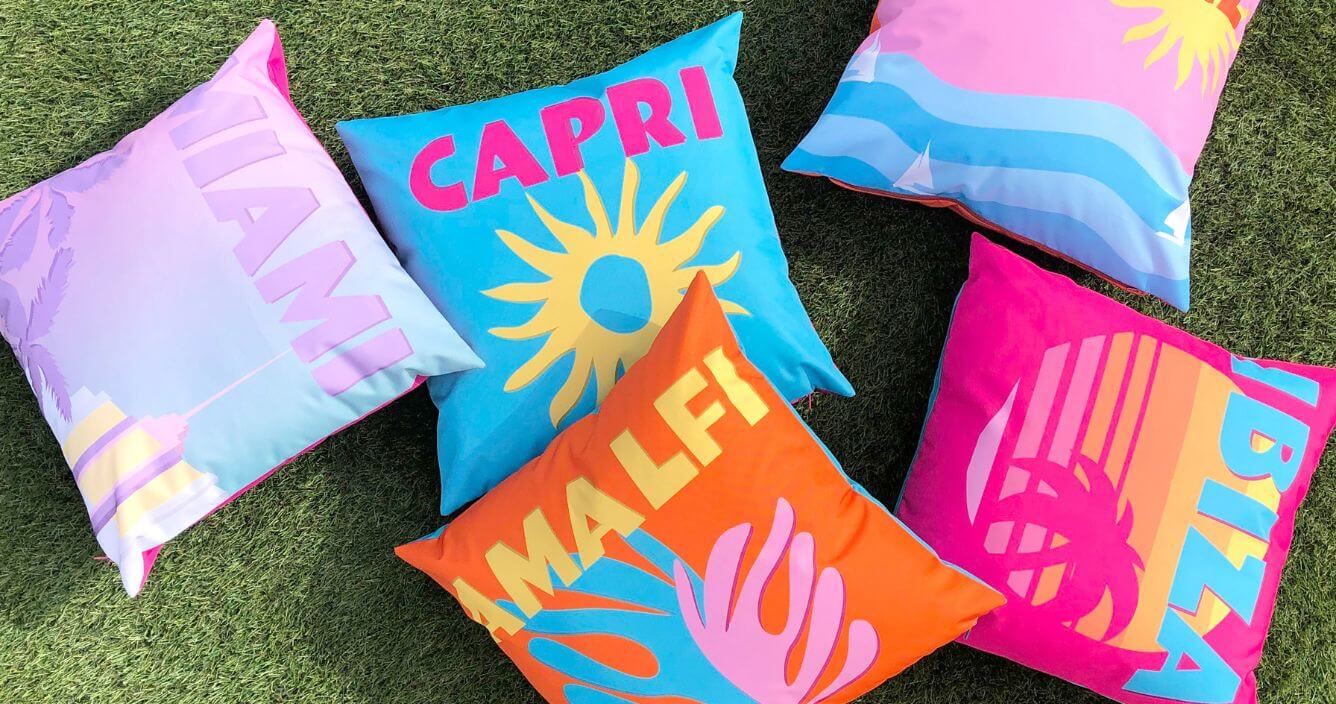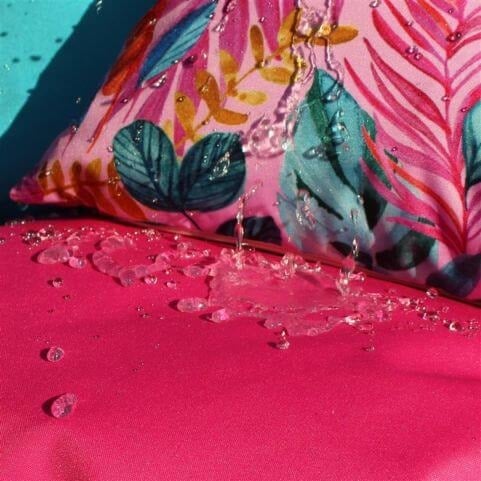Picture, if you will, the first day of summer. Skies are blue, the sun’s splitting, and your friends are on their way for lunch in the garden. Winter is a distant memory, and it feels like a lifetime since you stored away your outdoor cushions last autumn. You open the garage door, only to be met with the stuff of summer nightmares. Cushions strewn on the floor, creepy-crawlies everywhere you look, and little white spots that send a shiver up your spine – *gasp* – mildew.
No-one wants to start their summer off on a soggy note, so making sure your garden cushions are properly stowed away is essential. Whether you’re wrapping them up for winter or just expecting some heavy showers – we’re running through every detail of how to store outdoor cushions.
When it comes to stowing away your outdoor cushions – just like anything in life – if you fail to prepare, then prepare to fail. Your garden cushions should be washed, rinsed and completely dry before you even think about storing them away.
clean.
Cleaning should be your very first step when storing outdoor cushions. You might have the cleanest, driest, most airtight storage space on the market – but if your cushions are dirty when you put them away, they’ll be in even worse shape by the time you take them out.
Start by removing your outdoor cushion cover, and get rid of any loose dirt with a vacuum or brush. Using a solution of mild detergent and water, gently scrub the cover with a soft-bristled brush, paying particular attention to any stains. Make sure to spot-test your cleaning solution on a concealed area of the fabric, and always follow the care label on your outdoor cushion carefully.
If you need a more detailed breakdown, we’ve got a full guide to cleaning outdoor cushions over on our inspiration page.
dry.
Cleaning your outdoor cushions before you store them is essential, but it won’t do much good unless they’re thoroughly dried out afterwards. Stowing away cushions while they’re damp will cause mould and mildew to grow, leaving you with a musty surprise by the time summer rolls around.
Once you’ve washed your outdoor cushions, rinse them thoroughly with clean water to fully flush out any cleaning products. Allow your cushions to dry naturally – outdoors in a clean, dry area if the weather’s good, or indoors next to a fan or dehumidifier.
repair.
While you’re cleaning, drying and preparing your outdoor cushions for storage, keep an eye out for any signs of damage. While designed for durability, garden cushions can still become worn out over time. The earlier you start making repairs, the better chance your cushion has at maintaining its integrity.
Stretched seams, frayed fabric and worn-out zips are all potential hazards of outdoor life – and the sooner you intervene, the better. If your zipper is separated at the bottom, you can try squeezing the slider (the part you pull) with pliers to make the gap tighter. If it’s stuck, try clearing out debris with a small tool or applying some gentle lubricant. For severe damage or torn seams, we recommend taking your cushion to a fabric care specialist.
Once they’ve been cleaned, dried and assessed for damage – start thinking about where to store your outdoor cushions. There are tons of suitable storage options, but the most important thing is to make sure that they’re in a clean, dry and climate-controlled environment.
If you live in a drier climate, or you’re just looking to stow away your outdoor cushions for a short time, storing them outdoors is an ideal option.
The best place to store garden cushions outside is in an airtight container. This might be a dedicated deck box, furniture with built-in storage, or a weatherproof storage bin with an airtight lid. Just pop your cushions in – trying not to compress them too much – and tightly seal the lid. Wherever you’re storing your outdoor cushions, we recommend regularly checking to ensure no mould or mildew is growing.
If you don’t have an airtight container, or you’re just stowing away for a short period, there’s always the option of wrapping your outdoor cushions with hard-wearing material. Waterproof tarps, heavy-duty bin liners and durable Ziploc bags are all great options for short-term outdoor storage. Tightly secure your cushions, and pop them in a dry, clean spot. Make sure they’re shaded too, as the sun can be just as harmful as rain if given enough access to outdoor cushions.
Whether you’re stowing away for the winter or worried about the temperamental UK weather taking its toll, storing your outdoor cushions inside is often the only option. Garages, attics and garden sheds are perfect locations for long-term indoor storage, provided your cushions stay dry, elevated and clear of dust or critters.
If you’re lucky enough to have a garage, basement or garden shed at your disposal, they offer the perfect solution for long-term storage. These environments tend to be nice and cool with plenty of airflow, while also keeping a relatively consistent temperature. Even if you’re storing outdoor cushions inside, it’s optimal to use an airtight container or protective tarp. This will keep dust, pests and moisture well clear of your cushions.
If you don’t have a dedicated space for indoor storage, you can always keep your outdoor cushions in a closet or spare room. Wrap them in plastic bin bags or old blankets, and keep them elevated on shelves and racks if you’ve got the space. Use mothballs or cedar sachets to repel any pests and keep odours at bay. If you’re really stuck for space, there are plenty of services which rent out climate-controlled storage on a temporary basis.
Now that you know the dos and don’ts of storing outdoor cushions, let’s run through some of the most commonly asked questions…
While most garden cushions are designed with some level of water-resistance, this doesn’t mean you should leave them out in the rain. Just how waterproof your cushion is depends on how it’s been manufactured, but even the most weather-resistant design will take on damage if left out in the elements long enough.
All our outdoor cushions are resistant to both water and UV rays, but we still recommend bringing them back inside during periods of heavy weather. To prolong the lifespan of your outdoor cushions and keep them looking their best, allow them to fully dry indoors on a regular basis.
Vacuum packing your outdoor cushions is a great way to keep pests and dirt at bay, while saving you massive amounts of storage space. Just make sure your cushions are completely clean and dry before sealing them.
While our outdoor cushions use durable polyester pads that are designed to keep their shape, heavy compression may cause them to become damaged over time. So, if you do decide to vacuum pack your cushions, make sure to check up on them every now and again.
And there you have it – our comprehensive guide to storing outdoor cushions. It’s a lot to take in, so just remember the key points: make sure your cushions are completely clean and dry, then pop them in an elevated spot with good airflow.
Check out our full guide to cleaning outdoor cushions if you need a refresher. Or, update your home with stunning signature designs from our UV and water-resistant garden cushions range.




























